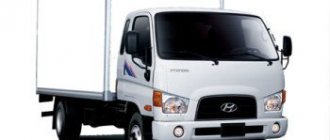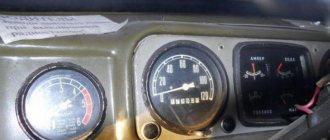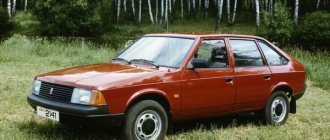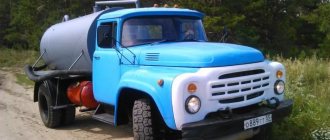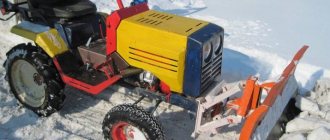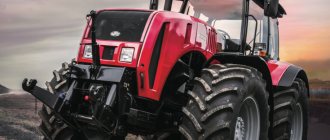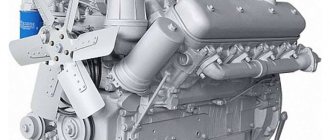Engine UAZ 469
A car engine characterizes most of the basic indicators of a vehicle. This definition is fully suitable for the UAZ 469. The engine of the Russian jeep corresponds to the purpose of the car 100%. The UAZ engine was selected by the designers for high traction properties, avoidance of overheating, and operation in difficult climatic conditions. This article will tell you about all the features of the UAZ 469 car engine.
Standard UAZ 469 engine
Regarding which engine is installed on the UAZ 469, we can say the following: The popular Russian SUV UAZ 469 was equipped at the manufacturer's plant with different types of power units over the years. These are standard engines for UAZ: ZMZ-21, UMZ-451MI, ZMZ-24, UMZ-249. Each UAZ 469 engine had its own characteristics, advantages and disadvantages.
Considering that this type of vehicle was intended for servicing and transporting command personnel of the Soviet army, increased demands were placed on the engine during vehicle production.
In parallel with the military order, the Ulyanovsk Automobile Plant produced cars for top officials of regional committees, district party committees, and heads of collective and state farms. This category of workers operated machines in harsh off-road conditions, mountainous, steppe regions, in forests, fields, meadows, hayfields, arable lands, and construction sites.
Therefore, the main criteria for automobile engines were: endurance, power, unpretentiousness. Despite their very respectable age, UAZ 469 cars from the 60s and 70s still function effectively to this day. This is largely due to the carefully selected internal combustion engine.
The technical services of the Ulyanovsk Automobile Plant paid enormous attention to the practical indicator of how much the UAZ 469 engine weighs. In combat conditions, when landing vehicles from aircraft, every kilogram of transported cargo plays a big role. Therefore, designers and technologists developed motors with blocks where the material was lightweight aluminum alloy.
Standard engines must have the highest degree of manufacturability in production and convenience, ease of repair in the most unsuitable conditions. It can be successfully repaired in the field, forest, camping and combat conditions, with a minimum of equipment and tools.
For this reason, the production engine has been modernized several times. To produce more technologically advanced engines, their production was transferred from the Zavolzhsky Motor Plant to the Ulyanovsk Motor Plant. Instead of the standard ZMZ-21 and ZMZ-24 engines, they began to install the UMZ-451MI in cars, and then the more modern UMZ-249 engine.
History of the development of the military UAZ
It was noted above that the first experimental models of the UAZ-469 were produced in 1964. However, development began back in the 50s of the 20th century. The first model, called UAZ-460, was designed in 1958. Apparently, the American Jeep was taken as a basis.
In 1964, a trial batch of modified cars was produced, called UAZ-469. By the way, in the automotive press, the very next year, one could see an image of this car and learn about some of the technical characteristics. This is surprising, considering the fact that mass production of the machines will begin only after 8 years.
The basis for the UAZ-469 model of 1972 was the reliable and advanced for those years 21st Volga. The capabilities of the UAZ amaze and surprise. For example, in 1974, several cars in basic configuration, that is, without anti-slip chains, winches, etc., were able to climb one of the Elbrus glaciers, to a height of 4.2 kilometers.
In 1985, an army SUV from the Ulyanovsk Automobile Plant began to be produced under the name UAZ-3151.
The history of the UAZ-469 ends at the beginning of the 21st century. In 2021, a limited edition of the UAZ-315196 is being produced, which has power steering, spring suspension, front disc brakes, a 112-horsepower engine, and Timken split axles. And already in 2022, this model disappears from the market, due to the fact that the specified batch of 5,000 cars is completely sold out. UAZ, in terms of military vehicles, is beginning to specialize in the Hunter Classic model.
Specifications
For a UAZ 469 car, engine power is of paramount importance. A more powerful power unit will always be able to overcome difficult sections of the road faster and reach high speeds on paved roads. An important indicator is fuel consumption.
The more fuel a car consumes, the less range it has with standard fuel tanks. Therefore, it is necessary to refuel more often, wasting precious time. And the second disadvantage is that you need to spend more money on fuel. An economical car with an unpretentious engine reduces costs for its owner.
| Specifications | Meaning |
| Motor brand | UMZ-451MI |
| Type | Petrol |
| Number of cylinders | 4 |
| Number of valves | 8 |
| Volume | 2445 cm³ / 2.5 liters |
| Cylinder section | 92 mm |
| Power | 75 l. With. |
| Nutrition | Carburetor K-129V |
| Consumption | 16 liters/100 km |
| Compression ratio | 6,7 |
| Resource | 150,000 km |
| Lubricants | Mineral oil and semi-synthetic oil |
| Weight | 167 kg |
Device
UMZ-451MI consists of units, mechanisms, elements, the characteristics of which are listed below in the text.
Clutch:
Dry, with one disk with a cross section of 254 mm.
Engine Mount:
Elastic due to rubber cushions.
Total number of supports 4
:
Crank mechanism:
The cylinders are assembled into a block, which is a casting. The block is cast from aluminum alloy. The sleeves pressed into it are replaceable “wet” ones made of cast iron.
Cylinder head
cast from aluminum alloy. Valve guides along with seats are inserted into it. All four cylinders have a common head.
Combustion chamber in the engine
made in a flat-oval configuration. It is located inside the cylinder head.
All pistons
motors are tinned, cast from aluminum alloy. Each piston is filled with tinned steel inserts that regulate the temperature.
Connecting rods
made of steel, forged. The cross-section of each of them is I-beam. Special bronze bushings are pressed into the upper heads of the connecting rods.
Crankshaft
on 5 supports, cast from cast iron, made with counterweights. The cross-section of the main journals is 64 mm, the connecting rod journals are 58 mm.
Bearings
, both main and connecting rod, are made with replaceable thin-walled liners made of steel and aluminum.
Liner thickness
, mm: main liner – 2.25; connecting rod bearing - 1.75; antifriction layer – 0.33.
Engine flywheel
cast from cast iron. On top of it there is a press-on gear ring, intended for starting the power unit.
The engine is equipped with a contact ignition distributor
. The arrangement of the cylinders and pistons of the UMZ-451MI engine is in-line. The entire piston group is rotated by one common crankshaft. There is also one distribution shaft and it is located at the bottom.
______________________________________________________________________________
______________________________________________________________________________
Engine UAZ-469, UAZ-31512, 31514 and its main parts
The UAZ-469, UAZ-31512, 31514 cars are equipped with UMZ-451, UMZ-417, 414 engines respectively. The engine of the UAZ-469, UAZ-31512, 31514 cars (Fig. 1, 2) is four-cylinder, four-stroke, overhead valve, carburetor with in-line cylinder arrangement and liquid cooling. This engine is equipped with a high-performance fuel pump type B8, a carburetor type K-129 and one full-flow oil filter instead of the two installed on the UMZ-451 engine. In addition, the engine uses a number of parts unified with the GAZ-24 engine. All this made it possible to improve the technical and economic performance of the engine and increase its service life before major overhaul to 150 thousand km.
Fig.1. Engine UAZ-469, UAZ-31512, 31514 longitudinal section 1 - oil pump; 2 - crankshaft; 3 — connecting rod; 4 - piston; 5 - fan; 6 - water pump; 7 — thermostat; 8 — exhaust valve; 9 — inlet valve; 10 — valve spring; 11 — rocker axis; 12— push rod; 13 — cylinder head; 14 — cylinder block; 15 — pusher; 16 - flywheel
Fig.2. Engine UAZ-469, UAZ-31512, 31514 cross section 1-crankshaft, 2-connecting rod, 3-piston, 4-oil filter, 5-exhaust pipeline; 6 — inlet valve; 7 — carburetor; 8 — crankcase ventilation filter; 9 — cylinder head; 10 — ignition distributor; 11-camshaft; 12 — starter; 13 - oil pump To reduce the longitudinal movement of the engine from the forces that arise when pressing the clutch pedal, and from the inertial forces that appear when braking and accelerating the car, the engine is connected to the frame with a special reaction rod. Parts of the crank mechanism of the UAZ-469, UAZ-31512, 31514 engine. The UAZ-469, UAZ-31512, 31514 cylinder block and the upper part of the engine crankcase, made as one piece, are cast from high-strength aluminum alloy. The cylinders are made of easily removable wet liners cast from gray cast iron. To increase wear resistance, the liner in the upper part is equipped with an insert made of acid-resistant cast iron. The cylinder block has drilled oil channels. The main oil passage runs the entire length of the block on the right side at the top of the crankcase. It communicates through five transverse channels with the bearings of the crankshaft and camshaft. In the crankcase of the UAZ-469, UAZ-31512, 31514 cylinder block, there are five crankshaft main bearing beds and five camshaft journal supports located in the transverse partitions and end walls. The main bearing caps are not interchangeable. The camshaft supports are located in the upper crankcase of the cylinder block on the left side. Bushings are pressed into them. The cylinder head of the UAZ-469, UAZ-31512, 31514 is common to all cylinders, cast from aluminum alloy. On the right are the intake and exhaust ports, in the middle are the combustion chambers, guide bushings and valve seats, and on the left are the holes for the pushrods and spark plugs. The inlet and outlet channels are made separately for each cylinder. The axes of the flat-oval combustion chambers are slightly shifted to the right relative to the cylinder axis, which ensures swirling of the working mixture in the chamber during the compression stroke and better combustion. Tightening the cylinder head nuts for UAZ-469, UAZ-31512, 31514 (Fig. 3) should be done after the vehicle has been run in and 1000 km after each head removal. To avoid warping of the head and to ensure a reliable seal, tightening must be done in two steps: first with a slight force, and then finally with a torque of 7.3-7.8 kg/cm.
Fig.3. The procedure for tightening the cylinder head nuts of UAZ-469, UAZ-31512, 31514 should be tightened smoothly without jerking, with one hand and without increasing the wrench arm. Tightening should only be done on a cold engine. Removing carbon deposits from the cylinder head, piston heads, intake valve heads and stems. Signs of the appearance of carbon deposits include engine overheating and detonation, as well as a drop in power and an increase in fuel consumption. To remove carbon deposits, it is necessary to remove the cylinder head and remove carbon deposits using metal scrapers and brushes. In this case, it is necessary to take measures to ensure that carbon deposits do not get into the gaps between the piston heads and cylinders. The pistons of the UAZ-469, UAZ-31512, 31514 engines are cast from aluminum alloy. There are three grooves on the cylindrical head of the piston (Fig. 4): the upper two grooves are used to install compression rings in them, and the lower one is for installing the oil scraper ring. The lower groove has two slots for draining oil into the crankcase, which is removed by the ring from the cylinder walls. The UAZ-469 piston skirt is oval-shaped. Fig.4. Installation of rings on the piston of the UAZ-469, UAZ-31512, 31514 engine 1 - piston; 2 — compression rings; 3 — annular disks; 4 — axial expander; 5 — radial expander; b — thermostatic ring The major axis of the oval is located in a plane perpendicular to the plane of the piston pin axis. The ovality value is 0.4±0.01 mm. In addition, the skirt at the top has a smaller diameter than at the bottom by 0.01-0.02 (0.015 is preferable) mm. To ensure that the piston operates on a cold UAZ-469, UAZ-31512, 31514 engine without knocking, a steel thermostatic ring is poured into the piston body at the junction of the piston head and the skirt. In the middle part of the piston there are two bosses with holes with a diameter of 25-0.01 mm for the piston pin. The axis of these holes is shifted by 1.5 mm to the right side (when viewed along the vehicle) from the middle plane of the piston. Piston rings UAZ-469, UAZ-31512, 31514: two compression rings and one oil scraper ring. Compression piston rings have a height of 2.5 -0.012 mm.
The outer surface of the upper compression ring is coated with porous chrome. Coating thickness - 0.08-0.13 mm. The outer surface of the lower compression ring is tinned. The thickness of the tin layer is 0.005–0.010 mm. On the inner cylindrical surface of both compression rings there is a conical chamfer, which, when installed on the piston, must face towards the piston bottom. After installing the rings into the cylinder, the mounting gap in the lock should be 0.3-0.5 mm. The oil scraper piston ring for UAZ-469, UAZ-31512, 31514 is composite. It consists of two identical annular disks 0.7 mm thick and 3 mm wide, axial and radial expanders. To reduce wear, the working surface of the ring discs is coated with hard chrome. The thickness of the chromium layer is 0.1 mm. The radial expander 5 has nine longitudinal holes to drain excess oil removed from the cylinder mirror. The piston pins of UAZ-469, UAZ-31512, 31514 are of the floating type, hollow, made of carbon steel. The outer diameter of the fingers is 25 mm, length is 66 mm. The outer surface of the fingers is hardened by high-frequency currents to a depth of 1-1.5 mm. Connecting rods UAZ-469, UAZ-31512, 31514 - I-section, steel, forged. Thin-walled bushings made of tin bronze are pressed into the upper one-piece heads of the connecting rods. To lubricate the piston pin, there is a round hole in the upper head of the connecting rod and in the bushing. The lower head of the connecting rod is detachable. There is a hole with a diameter of 1.5 mm in the lower head of the connecting rod (and in the liner), through which lubricant is supplied to the cylinder walls and to the camshaft cams. The UAZ-469, UAZ-31512, 31514 crankshaft is five-bearing, cast from magnesium cast iron. The front end of the UAZ-469 crankshaft is sealed with a self-clamping rubber oil seal 16 (Fig. 5), pressed into the timing gear cover. The axial forces of the crankshaft are perceived by the front thrust bearing through two thrust washers 10 and 11, made of steel tape filled with babbitt.
Fig.5. The front end of the crankshaft of UAZ-469, UAZ-31512, 31514, installed in the engine 1—dust deflector; 2 — pulley hub; 3 - ratchet; 4 - crankshaft; 5 - pulley; 6 — pin; 7 — timing gear cover; 8 — oil deflector washer; 9 — thrust washer; 10— front thrust washer; 11 — rear thrust washer; 12 - protrusion; 13 — fixing pin; 14 - gear; 15 — oil seal body; 16 — oil seal The amount of axial clearance in the thrust bearing is 0.075–0.175 mm. This is achieved by selecting thrust washers of appropriate thickness. The crankshaft main and connecting rod journals are cast hollow. The cavities in the connecting rod journals are hermetically sealed with screw plugs. The rear end of the crankshaft of UAZ-469, UAZ-31512, 31514 is sealed with an oil seal consisting of two half-rings made of asbestos cord impregnated with graphite, placed in cages. The main and connecting rod bearings of the crankshaft of UAZ-469, UAZ-31512, 31514 are equipped with thin-walled interchangeable liners made of low-carbon steel tape filled with babbitt. The total thickness of the main bearing shell is 2.25 and connecting rod bearings are 1.7 mm. Two liners are installed in each bearing. At one of the joints of each liner there is a fixing protrusion, which, entering the grooves of the block bed or connecting rods, eliminates the possibility of axial movement and rotation of the liner in the bed. The crankshaft flywheel is cast from gray cast iron. To start the engine with a starter, a steel toothed rim is pressed onto the flywheel. Repair of the crankshaft of the UAZ-469, UAZ-31512, 31514 engine. Repair of the crankshaft of the UAZ-469, UAZ-31512, 31514 consists of regrinding the main and connecting rod journals to fit the new repair dimensions of sets of connecting rod and main bearings produced as spare parts. Radial clearances in the connecting rod and main bearings of the crankshaft should be in the range of 0.026–0.077 and 0.026–0.083 mm, respectively. The journals are ground to a tolerance of 0.013 mm. Thus, when regrinding the shaft journals for the first repair kits of liners, the dimensions of the connecting rod and main journals should respectively be in the range of 57.750–57.737 and 63.750–63.737 mm. The repair size of the connecting rod journals of the UAZ-469, UAZ-31512, 31514 crankshaft may not coincide with the repair size of the main journals, but all connecting rod journals and all main journals should be ground to one repair size. The chamfers and holes of the front and rear ends of the crankshaft are not suitable for mounting the shaft in the center of the grinding machine. To do this, it is necessary to make removable center glasses: the front center is pressed onto a neck with a diameter of 38 mm, and the rear center is centered along the outer diameter of the flange (122 mm) of the shaft and bolted to it. When making transition centers, ensure that the center hole is concentric with the mounting hole. If this condition is not met, it is impossible to ensure the necessary concentricity of the flywheel and gear seats to the axes of the main journals. When grinding the connecting rod journals, the UAZ-469, UAZ-31512, 31514 crankshaft is installed along additional centers coaxial to the axes of the connecting rod journals. When grinding connecting rod journals, be careful not to touch the side surfaces of the journals with the grinding wheel. Otherwise, the axial clearance of the connecting rods will be excessively large and the connecting rods will knock. Maintain the radius of transition to the side surface within 1.2-2 mm. The surface roughness of the crankshaft journals after processing should be no more than 0.32 microns. Grinding is carried out with abundant cooling with emulsion. During the grinding process it is necessary to maintain:
— the distance between the axes of the main and connecting rod journals is within 46±0.05 mm;
— ovality and taper of the necks no more than 0.01 mm; angular position of the connecting rod journals within ±0°10′;
- non-parallelism of the axes of the connecting rod journals with the axis of the main journals is not more than 0.012 mm over the entire length of the connecting rod journal;
— runout (when installing the shaft with the outer journals on the prisms) of the middle journals is no more than 0.02 mm, of the journal for the camshaft gear up to 0.03 mm, and for the journals for the pulley hub and rear oil seal up to 0.04 mm. After grinding the journals, the crankshaft of UAZ-469, UAZ-31512, 31514 is washed, and the oil channels are cleaned of abrasives and resinous deposits. At the same time, the plugs of the dirt traps are unscrewed. After cleaning the dirt traps and channels, screw the plugs back into place and core each of them to prevent spontaneous unscrewing. The oil channels should also be cleaned during operational repairs of the engine, when the crankshaft is removed from the block. After repair, it is recommended to reassemble the crankshaft with the same flywheel and clutch that were on it before repair. In this case, the clutch should be installed on the flywheel of the UAZ-469, UAZ-31512, 31514 according to the marks marked on both parts, one opposite the other, near one of the bolts securing the clutch housing to the flywheel. Before installation on the engine, the crankshaft is dynamically balanced. It is first necessary to center the clutch driven disc. The imbalance is eliminated by drilling out the metal in the flywheel rim at a radius of 158 mm with a 12 mm drill. The drilling depth should not exceed 12 mm. The permissible imbalance is no more than 70 gf/cm.
Repair and assembly of the connecting rod-piston group of UAZ-469, UAZ-31512, 31514 engines. The technical condition of the parts of the UAZ-469, UAZ-31512, 31514 piston group is of significant importance; their condition usually determines the suitability of the engine for further operation. Replacing piston rings UAZ-469, UAZ-31512, 31514 Usually the need to replace piston rings arises after 70-90 thousand km of vehicle mileage, depending on the quality of the operating materials (fuel, oil) used and the general operating conditions of the vehicle. It is recommended to remove and put rings on the piston using a puller. Piston rings UAZ-469, UAZ-31512, 31514 repair sizes differ from the nominal ones only in the outer diameter. Rings of one or another repair size are designed for installation in cylinders machined to a given repair size, and for installation in worn cylinders of the next smaller repair size by filing their joints until a gap in the lock is 0.3-0.5 mm. The gap is checked in the lock of the ring inserted into the cylinder. For reground cylinders, the rings are fitted along the top part, and for worn cylinders - along the bottom part of the cylinder (within the stroke of the piston rings). When adjusting, the ring is installed in the cylinder in the working position, i.e. in a plane perpendicular to the cylinder axis, and is advanced using the piston head. The joints of the rings must be sawed so that the planes of the joints are parallel when the ring is compressed. After adjusting the rings to the cylinders, it is necessary to check the lateral clearance between the rings and the grooves in the piston, which should be: for the upper compression ring in the range of 0.050-0.082, for the lower - 0.035-0.067 mm. With gaps of 0.15 mm or more, replacing the piston rings of UAZ-469, UAZ-31512, 31514 will not eliminate increased oil consumption - “waste”. In this case, simultaneously with replacing the rings, the pistons should also be replaced. When replacing only the piston rings without replacing the pistons, it is necessary to remove carbon deposits from the piston bottoms, from the annular grooves in the piston head and the oil drain holes located in the oil ring grooves. When using new or re-ground cylinder liners for UAZ-469, UAZ-31512, 31514, it is necessary that the upper compression ring be chrome-plated, and the lower one be tin-plated or phosphated. When replacing only piston rings, without repairing or replacing the liner, all of them must be tinned or phosphated, since the chrome-plated ring is very poorly worn-in to a worn liner. Before installing the piston into the cylinder, the joints of the compression rings and oil scraper ring disks must be separated at an angle of 180° relative to the previous ring. The location of the expansion joints does not matter. Replacing UAZ-469, UAZ-31512, 31514 pistons For new and repair-sized cylinders, UAZ-469, UAZ-31512, 31514 pistons are selected according to the force required to pull the feeler tape inserted into the gap between the piston and the liner. The pulling force of a tape with a thickness of 0.05 mm and a width of 13 mm should be in the range of 3.5-4.5 kgf. The feeler tape is placed in a plane perpendicular to the piston pin axis. To ensure correct selection to the cylinder, the UAZ-469, UAZ-31512, 31514 piston must be without a piston pin, which distorts the true dimensions of its skirt when the piston is cold. In this case, the piston is installed in the cylinder with the skirt up, otherwise, when pulling, the probe tape will bite the piston skirt due to its taper. In partially worn cylinders, as a rule, pistons of the same size (nominal or repair) are installed as the pistons that previously worked in this engine had. However, it is advisable to select a set of larger pistons to reduce the gap between the piston skirt and the cylinder bore. In this case, the gap between the piston skirt and the cylinder bore should be checked in the lower, least worn part of the cylinder. The gap in this part of the cylinder should not be allowed to decrease below 0.02 mm. To make selection easier, pistons are sorted by the largest skirt diameter. The letter designation of the sorting group is stamped on the bottom of the UAZ-469, UAZ-31512, 31514 pistons of nominal size. The letters indicate the following dimensions of the piston skirt diameter, mm: A - 91.988-92.000; B—92,000—92,012; B -92.012—92.024; G - 92.024-92.036; D - 92.036-92.048. On the piston heads of the UAZ-469 repair size, instead of a letter designation, the size of the piston skirt diameter is directly stamped, rounded to 0.01 mm, for example 92.5 mm. The tolerance for the diameter of the piston skirt of the repair size is -0.012 mm. In addition to selecting pistons for cylinders based on skirt diameter, they are also selected based on weight. This is necessary to keep the engine balanced. The difference in the mass of the lightest and heaviest pistons for one engine should not exceed 4 g. Pistons are installed in the cylinders of UAZ-469, UAZ-31512, 31514 using a device. The internal diameter A of the ring is made equal to the size of the cylinder (nominal or repair) with a tolerance of ±0.01 mm. When installing pistons into the cylinders of UAZ-469, UAZ-31512, 31514, it is necessary that the “front” mark stamped on the piston faces the front end of the block. On all repair size pistons, the holes in the bosses for the piston pin are made to the nominal size. The surface roughness should not exceed 0.63 microns. Taper and ovality of the hole are allowed no more than 0.005 mm. When processing, the perpendicularity of the hole axis to the piston axis must be ensured, the permissible deviation is no more than 0.05 mm over a length of 100 mm. Spare parts include pistons along with matching piston pins and retaining rings. Repair and replacement of piston pins of UAZ-469, UAZ-31512, 31514 To replace piston pins of UAZ-469, UAZ-31512, 31514 without pre-machining the holes in the piston and in the upper head of the connecting rod, repair piston pins are used, increased in diameter by 0.08 mm. The use of repair pins increased by 0.12 and 0.20 mm requires pre-treatment of the holes in the piston bosses and in the upper head of the connecting rod. Piston pins of UAZ-469, UAZ-31512, 31514 are repaired by grinding them from large repair sizes to smaller ones or by chrome plating, followed by processing to the nominal or repair size. Before pressing the piston pin out of the piston, it is necessary to remove the piston pin retaining rings with pliers. Press out and press the finger into the device. Before pressing out the pin, the piston is heated to 70° C. Repair of connecting rods UAZ-469, UAZ-31512, 31514 is reduced to replacing the upper head bushing and subsequent processing of it to fit a piston pin of a nominal size or to processing of the bushing in the connecting rod for a repair-size pin. Spare parts are supplied with bushings of the same size, rolled from bronze tape OTSS4-4-2.5 with a thickness of 1 mm. When pressing a new bushing into the connecting rod, it is necessary to ensure that the hole in the bushing coincides with the hole in the upper head of the connecting rod to ensure the supply of lubricant to the piston pin. After pressing, the bushing is compacted to a diameter of 24.3 + 0-045 mm, and then reamed or bored to the nominal or repair size. The distance between the axes of the holes in the lower and upper heads of the connecting rod UAZ-469, UAZ-31512, 31514 should be equal to 168±0.05 mm; permissible non-parallelism of axes in two mutually perpendicular planes is not more than 0.04 mm over a length of 100 mm; ovality and taper should not exceed 0.005 mm. To maintain the specified dimensions and tolerances, it is recommended to deploy the bushing of the upper hole of the connecting rod in the jig. After reaming, the hole is finished using a special grinding head. The roughness after processing should not exceed 0.63 microns. Connecting rods UAZ-469, UAZ-31512, 31514, the holes for the bearings in the lower head of which have an ovality of more than 0.5 mm, are rejected. Assembling the piston group of UAZ-469, UAZ-31512, 31514 To ensure that the piston group of UAZ-469, UAZ-31512, 31514 operates without knocking, the piston, piston pin and connecting rod are matched to each other with the minimum necessary clearances for their normal lubrication.
The piston pin is selected to the upper head of the connecting rod with a gap of 0.0045-0.0095 mm. The pin is installed in the piston with an interference fit of 0.0025-0.0075 mm. Sub-assembly of the piston group of UAZ-469, UAZ-31512, 31514 is performed in the same device as disassembly.
It should be borne in mind that to ensure engine balancing, the difference in the mass of the pistons installed in the engine together with connecting rods should not exceed 8 g. The piston pin retaining rings should sit in their grooves with some interference. It is not recommended to use used retaining rings. Taking into account the difficulty of selecting a piston pin to the piston and connecting rod (the need to ensure nominal fits), pistons are supplied as spare parts assembled with a piston pin and retaining rings. If there is a separate piston, connecting rod and pin, then they must be assembled only with the same color marking (white, green, yellow or red).
______________________________________________________________________________
______________________________________________________________________________
- Clutch and gearbox UAZ Hunter
- Transfer case and driveshafts UAZ Hunter
- Drive axles UAZ Hunter
- Adjusting the steering mechanism of the UAZ Hunter
______________________________________________________________________________
______________________________________________________________________________
- Checkpoint UAZ-Patriot
- Razdatka UAZ-Patriot
- Drive axles UAZ-Patriot
- UAZ-Patriot suspension
- Steering UAZ-Patriot
- UAZ Patriot power steering faults and their elimination
- Components of the UAZ-Patriot hydraulic brake drive
- UAZ-469 engine and its main parts
- Gearbox UAZ-469
- Drive front and rear axles of UAZ-469
- Clutch of UAZ-469 cars
______________________________________________________________________________
- Cylinder block and timing belt for UAZ-31512, 31514 engines
- Front and rear suspensions UAZ-31512, 31514
- Operations for assembly and disassembly of UAZ-31512, 31514 bridges
- Steering UAZ-31512, 31514 and its parts
- Brake system UAZ-31512, 31514
- Gearbox UAZ-452
- UAZ-452 clutch and its parts
- Transfer case UAZ-452
- UAZ-452 bridges and its components
- Gearbox UAZ-3909, UAZ-2206
- Cardan transmission UAZ-3909, UAZ-2206
- Front axle UAZ-3909, UAZ-2206
- Brakes UAZ-3909, UAZ-2206
- Clutch UAZ-3303
- Transfer case UAZ-3303
- Rear axle UAZ-3303
- Steering of UAZ-3303
- Cylinder block and crankshaft ZMZ-409
- Timing belt and valves ZMZ-409
- Lubrication system ZMZ-409
- Cooling and power system ZMZ-409
- Parts of the UMZ-421, UMZ-4218 cylinder block
- Timing belt and valves UMZ-421, UMZ-4218
- Lubrication system UMZ-421, UMZ-4218
- Cooling system UMZ-421, UMZ-4218
- Fuel system UMZ-421, UMZ-4218
What diesel engine can be installed on the UAZ 469 without modifications?
This question is always relevant for car owners who have a similar car model for private use. A diesel engine has many advantages over a gasoline engine.
Operating a diesel engine is cheaper, fuel costs are lower, and the gain in power is significant. Diesel from foreign car models is best suited for the UAZ 469. The simplest, most unpretentious, budget engine is a naturally aspirated two-liter 2C-T from a Toyota with 88 horsepower.
If we consider more reliable expensive options, then for more comfortable movement and transportation of goods, NISSAN-TD27ETi power units with 130 horsepower are suitable. Diesels from Mercedes models OM 616 and OM 617 received maximum popularity for installation in UAZ. This is the most reliable and unpretentious diesel engine in the UAZ 469, most often installed on these car models.
Records
It is no secret that the Soviet automobile industry, for its time, was at a very high level. And when it came to military developments, the factories of the Soviet Union were unsurpassed leaders.
And also interesting: ✅ How does all-wheel drive work on a Suzuki Grand Vitara - avtochehol.su "
Thus, the UAZ-469 model set a world record, indirectly confirming the high level of the car:
32 people were able to fit into the UAZ-469, with a total weight of 1.9 tons. This event is included in the Guinness Book of Records. Before this, the Kia Spectra car managed to accommodate 23 people.
Specifications
The UAZ 469 vehicles were equipped with a 451MI engine, which was in many ways similar to the Volgovsky ZMZ 402. The UAZ 469 engine replaced the outdated GAZ-69 as a modernized vehicle. During development, many design features were taken from the GAZ-21 and GAZ-24.
In parallel with this, a civilian version of the car was produced with the marking 469B, which was renamed in 1985 and received the marking UAZ 31512.
Let's consider the main technical characteristics of the UAZ 469 engine, as well as the device:
UAZ-451MI
| Name | Description of characteristics |
| Model | 451MI |
| Type | Carburetor |
| Number of cylinders | 4 |
| Number of valves | 8 |
| Volume | 2.5 liters (2445 cm3) |
| Cylinder diameter | 92 mm |
| Power | 75 hp |
| Nutrition | Carburetor K-129V |
| Consumption | 16 liters per 100 km |
| Compression ratio | 6,7 |
| Resource | 150 thousand km |
| Oils that flow | Mineral or semi-synthetic |
UAZ-4178
| Name | Description of characteristics |
| Model | UMZ 4178 |
| Type | Carburetor |
| Number of cylinders | 4 |
| Number of valves | 8 |
| Volume | 2.5 liters (2450 cm3) |
| Cylinder diameter | 92 mm |
| Engine power | 92 hp |
| Consumption | 15.5 liters per 100 km |
| Resource | 150+ thousand km |
ZMZ-4021.10
| Name | Description of characteristics |
| Model | ZMZ 4021.10 |
| Type | Carburetor |
| Number of cylinders | 4 |
| Number of valves | 8 |
| Volume | 2.5 liters (2450 cm3) |
| Cylinder diameter | 92 mm |
| Power | 95 hp |
| Econorms | From Euro-0 |
| Consumption | 15.5 liters per 100 km |
| The amount of oil in the internal combustion engine | 5.6 liters |
| Resource | 250+ thousand km |
| Oils that flow | 5W-30, 5W-40, 10W-30, 10W-40, 15W-40 |
Engine markings
© Publication, “Car Atlases”, 2001 © Contents, Berezin E.B., Fedorochev A.A., Cheprasov V.N., Shiyan G.V., 2001
Marking (identification number) of engines is applied on a special platform located on cylinder block on the left side.
The marking includes two parts, separated by an asterisk: descriptive, consisting of six characters, and indicative, consisting of eight characters (numbers and letters of the Latin alphabet).
In the descriptive part, the first three digits (421) indicate the index of the base model, the fourth digit is the modification index (if absent, a zero is given). The fifth character is numbers indicating the climate version (0 - general climate version, 1 - northern, 7 - tropical) or letters (C - compression ratio 8.2, general climate version; T-compression ratio 8.2, tropical version). In the last place there is a zero or letters indicating: A - diaphragm clutch, P - recirculation valve. The index part consists of eight characters. The first character (letter of the Latin alphabet or number) indicates the year of manufacture of the engine.
The following notations are accepted:
| 1971 | 1972 | 1973 | 1974 | 1975 | 1976 | 1977 | 1978 | 1979 | 1980 | 1981 | 1982 | 1983 | 1984 | 1985 | 1986 | 1987 | 1988 | 1989 | 1990 | 1991 | 1992 | 1993 | 1994 | 1995 | 1996 | 1997 | 1998 | 1999 | 2000 |
| 1 | 2 | 3 | 4 | 5 | 6 | 7 | 8 | 9 | A | B | C | D | E | F | G | H | J | K | L | M | N | P | R | S | T | V | W | X | Y |
| 2001 | 2002 | 2003 | 2004 | 2005 | 2006 | 2007 | 2008 | 2009 | 2010 | 2011 | 2012 | 2013 | 2014 | 2015 | 2016 | 2017 | 2018 | 2019 | 2020 | 2021 | 2022 | 2023 | 2024 | 2025 | 2026 | 2027 | 2028 | 2029 | 2030 |
| 1 | 2 | 3 | 4 | 5 | 6 | 7 | 8 | 9 | A | B | C | D | E | F | G | H | J | K | L | M | N | P | R | S | T | V | W | X | Y |
The second and third digits of the index indicate the month of issue; the last five digits indicate the engine serial number from the beginning of the month.
An example of the marking of a 421.10 engine with a compression ratio of 7.0, in a tropical version, with a diaphragm clutch, manufactured in December 1999:
Source
Service
Maintenance of the power unit on the UAZ 469 is carried out according to the standard scheme. Thus, the service interval is 15,000 km before the first major overhaul. After restoring the engine, it is recommended to carry out maintenance every 10-12 thousand km in order to preserve the life of the engine.
During maintenance, the engine oil and oil filter are changed. So, mostly car enthusiasts like to pour mineral or cheap semi-synthetic oil into the engine. Moreover, if you take mineral water, then it is not of the best quality that ends up in the power unit.
Every second for a UAZ engine is a comprehensive replacement of consumables. In it, the vehicle owner must perform the following technical work:
Fault overview
All engines are repaired and serviced early. This is necessary because engines, like cars, are designed for use in difficult conditions. And in modern Russian conditions, when using low-quality diesel fuel, the filter devices in the engine become clogged. This happens especially often in winter. As a result, the car loses traction and ceases to be powerful. In the worst case, it might just end up in the middle of the road.
Similar article Engine oil for UAZ Patriot ZMZ 409
Attention! Experienced mechanics recommend performing maintenance every 10 thousand kilometers. This will increase the service life of the power unit.
Another weak point is the 5-bearing crankshaft, which is cast from cast iron. When overheated, it cracks. If not noticed in time, it will fail and its destruction can harm the entire engine. This is why maintenance at 10 thousand kilometers is so important. Since operation in difficult conditions makes itself felt by all kinds of overheating and wear.
The UAZ engine begins to consume a lot of oil when the crankshaft seal breaks. The problem is also observed in the cylinder head. Aluminum alloy quickly cracks and the cylinder head becomes unusable before the service life of the entire engine.
Due to clogged air filter devices, engines can consume too much fuel. Experienced mechanics advise changing the filter after a run of 20 thousand kilometers.
However, from a number of advantages of the power unit on the UAZ 469, the following can be highlighted:
- repairable. All engine models can be repaired in a garage;
- lower fuel consumption compared to other engines, for example Japanese ones. Engines from Japan, created specifically for SUVs, consume up to 20 liters at a minimum. This one is no more than 15;
- The UAZ 469 can transport cargo over long distances. The engines of this machine can withstand serious overloads.
If the engine breaks down and there is no suitable engine for the car nearby, then the UAZ 469 is usually equipped with a two-liter 2 ST from Toyota. He copes well with the actions assigned to him.
If money allows, car owners usually change the engine to a Nissan TD 27. This is also one of the most reliable engines. He is hardy and does not require close attention.
Similar article Technical characteristics of the Mercedes OM 612 engine
Tuning
Tuning the UAZ 469 engine with a volume of 2.5 liters is carried out by analogy with the engine produced by ZMZ 402. Since the designs are similar, tuning the power unit is quite simple.
To increase power characteristics, it is necessary to bore the cylinder block to dimensions of 95 mm. In this case, lightweight pistons and a crankshaft are installed in the engine. To ensure maximum effect, it is recommended to change the cylinder head to an injection one and, accordingly, install an electronic fuel injection system.
Do not forget that lightweight valves and guide bushings should be installed in the new cylinder head. All this will make the engine lighter by several tens of kilograms.
To prevent the power unit from overheating during operation, a cooling system kit is installed, which includes a sports pump and silicone pipes for the engine cooling system.
Instead of the original copper radiator, you need to mount a lightweight three-row aluminum one. Also, you will have to change the high-voltage wires and the ignition system. A separate item is the installation of a new clutch kit, as well as changing the ignition box.
What engines are installed on UAZ cars?
Motor for 469 model
Engines for the UAZ 31514 are available in several versions. Based on the type of fuel, they are divided into gasoline and diesel. Many characteristics of the vehicle, including fuel consumption, depend on which engines are installed in the UAZ.
For example, a UAZ ICE 210.10 gasoline engine with a volume of 2.4 liters has the following characteristics: power - 91 hp. s., fuel consumption - almost 12 liters per 100 km. UMZ 4178.10 engines of the same volume already have 87 horses and fuel consumption increases by one and a half liters.
Engines for UAZ Patriot 2005
The cars produced during this period were equipped with engines with distributed injection of gasoline of the ZMZ 40905 series with a power of 128 hp. SUVs were produced in small batches with an earlier version of the ZMZ 514 diesel engine, which developed a power of 113 hp, and with an imported Iveco F1A engine, used until 2011.
ZMZ 40905 with a power of 128 hp
The internal combustion engines had two working volumes: 2235 and 2287 cm3. Despite the reduced fuel consumption and increased torque, diesel engines were not particularly popular among buyers and sold poorly.
General characteristics of engines
The main suppliers of engines for UAZs were the Ulyanovsk Motor Plant and the Zavolzhsky Motor Plant. UMZ has become famous for being practically the only Russian manufacturer of engines for off-road vehicles. All modern engines produced from the plant’s assembly line meet Euro-4 standards.
ZMZ produces more than 80 different modifications of engines ranging from 2.2 to 4.6 liters. The units of this plant are installed on both small SUVs and buses of domestic and foreign companies.
There are other types of engines that are installed on UAZ 31514 vehicles:
The Andoria engine, installed on UAZ 31514, Iveco and UAZ Patriot vehicles, is produced not in Russia, but in Poland. These engines are in demand not only at the Ulyanovsk Automobile Plant. They are also installed on other Russian-made vehicles.
Basic engine UMZ 421.10 for UAZ
The main difference between the UMZ 4218.10 is the gas exhaust system, which is not configured. This simplifies the installation of the engine on UAZ vehicles, even with a carriage-type body. Currently, motors of this series have several modifications.
UAZ 39626 and Patriot engines
The UAZ 39629, otherwise known as a “sanitary” vehicle, is most often used for transporting patients and is available in most medical centers. Widely used in both cities and rural areas. These machines are equipped with three different engines.
UAZ Patriot cars are equipped with a four-cylinder, four-stroke engine of the ZMZ 409.10 series. The valves are located at the top, and the cooling is liquid. The ignition system of this engine is microprocessor-based, fuel injection is distributed. The ZMZ-51432 diesel engine for the UAZ Patriot is simply a necessity.
Diesel fuel is more economical and practical
In Russia, diesel fuel is gradually becoming fashionable, but until recently the production of diesel engines was just a plan. Foreign diesel engines, as a rule, were not suitable for the UAZ Patriot, and attempts to aggregate them were abandoned.
Reviews of the UAZ Patriot diesel engine from the foreign company IVECO F1A end with negative reviews about its quality. Maybe because Ulyanovsk or Trans-Volga engines are more common for Russian cars. The volume of the foreign engine is 2.3 liters and the power is 116 horses. The Italian engine is noisier and less powerful. However, owners of a Patriot with a foreign engine will be pleased with good traction and fairly economical fuel consumption - just under 10 liters per 100 km.
Not long ago, the Zavolzhsky Motor Plant began producing a diesel engine for the UAZ Patriot and UAZ Pickup SUVs. The ZMZ-51432 engine is a small-displacement engine, its volume is 2.2 liters, and complies with the Euro-4 standard. The engine has a maximum power of 114 horsepower, 3500 rpm and low fuel consumption.
The engine has many original parts, which has improved its energy and economic performance. At the same time, emissions of harmful substances have been reduced: by half compared to engines that comply with Euro-3. The noise level has decreased in accordance with standard requirements.
Operating principle of ZMZ 409 series engines
The standard ZMZ 409 engine is equipped with a cast iron cylinder block on which an aluminum 16-valve head is located. The valves are controlled by two camshafts driven by a chain from the crankshaft.
The gap between the cam and the valve stem is adjusted by a hydraulic compensator. Gasoline is supplied to the intake manifold cavity using injectors with a microprocessor control unit.
The ignition system consists of individual coils mounted in spark plug wells.
The ZMZ 409 motor has forced liquid cooling. The refrigerant is supplied using a separate pump. The engine temperature is maintained within specified limits by a thermostat located in the line. The radiator is equipped with a fan with a viscous coupling that provides air supply depending on the temperature. The design of the engine allows the installation of a gas injection system (it is installed at dealerships).
The 409 series internal combustion engine belongs to the Euro-4 environmental class and is equipped with an improved catalytic converter and a control unit with the appropriate software version. The neutralizer is located in a separate housing attached to the exhaust manifold. The design uses 2 oxygen sensors that adjust the composition of the fuel mixture.
Main technical characteristics of the 409 series injection engine:
| Engine capacity | 2.3-2.7 l. depending on modification |
| Developed power | Up to 143 forces |
| Rated torque | Up to 230 Nm at 3900 rpm |
| Compression | 9 |
| Fuel | Gasoline no less than AI 92 |
| Consumption in city mode | About 12 liters |
| Oil consumption | 100 grams per 1000 km. |
| Oil type | Depending on the season and modification, from 5W-30 to 20W-40 |
| Engine oil volume | 7 liters, to replace you need to fill about 6 |
| Engine weight | 190 kg. |
| Designation of the descriptive part /VDS/ of the identification number of engines of JSC ZMZ when marking them | ||
| Full engine designation according to design documentation | VDS | Characteristic features of the completeness and design of the engine |
| 409.1000400 | 409000 | Basic complete set in version “U2” according to GOST 15150-69 with KMPSUD type “Mikas 7.2”, with piston D=95.5 mm for UAZ vehicles with power steering |
| 409.1000400-10 | 40900A | Engine in version “U2” according to GOST 15150-69 with a pulley for two poly-V belts for UAZ vehicles with power steering and anti-toxic systems |
| 40907.1000400 | 409070 | Complete set in tropical version with KMSUD type "Mikas 7. 2" with a pulley for two ribbed belts for UAZ vehicles with power steering |
| 40907.1000400-10 | 40907A | Complete set in tropical version with KMSUD type “Mikas “7.2′” with a pulley for two poly-V-belts for UAZ vehicles with power steering and anti-toxic devices |
| 409.1000400-01 | 40900V | Engine in the “U2” version with a pulley for two poly V-belts with a starter and a Bosch lance generator for UAZ vehicles with power steering |
| 409.1000400-11 | 40900С | Engine in version “U2” with a pulley for two poly-V belts with a starter and generator for UAZ vehicles with power steering and anti-toxic devices |
| 40907.1000400-01 | 40907B; | Engine in the “T2” version with a pulley for two poly-V belts with a starter and a generator for UAZ vehicles with power steering |
| 40907.1000400-11 | 40907С | Engine in “T2” version with a pulley for two poly-V belts with a starter and generator for UAZ vehicles with power steering and anti-toxic devices |
| 409.1000400-30 | 40900N | Complete set in version "U2", with KMSUD type "Mikas" 7.2, with a generator and starter for UAZ vehicles with power steering. |
| 409.1000400-02 | 40900D | Complete set in version "U2", with KMSUD type "Mikas" 7.2, with clutch for UAZ vehicles. |
| 409.1000400-12 | 40900E | Complete set in version “U2”, with KMSUD type “Mikas” 7.2, with clutch for UAZ vehicles with anti-toxic devices. |
| 40907.1000400-02 | 40907D | Complete set in version "T2", with KMSUD type "Mikas" 7.2, with clutch for UAZ vehicles. |
| 40907.1000400-12 | 40907E | Complete set in the “T2” version, with KMSUD type “Mikas” 7.2, with a clutch for UAZ vehicles with anti-toxic devices. |
| 409.1000400-03 | 40900F | Complete set in version "U2", with KMSUD type "Mikas" 7.2, with generator and starter, with clutch for UAZ vehicles. |
| 409.1000400-13 | 40900G | Complete set in version "U2", with KMSUD type "Mikas" 7.2, with generator and starter, with clutch for UAZ vehicles with anti-toxic devices |
| 40907.1000400-03 | 40907F | Complete set in version "T2", with KMSUD type "Mikas" 7.2, with generator and starter, with clutch for UAZ vehicles. |
| 40907.1000400-13 | 40907G | Complete set in version "T2", with KMSUD type "Mikas" 7.2, with generator and starter, with clutch for UAZ vehicles with anti-toxic devices |
| 409.1000400-33 | 40900J | Complete set in version “U2”, with KMSUD type “Mikas” 7.2, with a pulley for two poly V-belts, with a generator and starter, with a clutch for UAZ vehicles with power steering. |
| 40907.1000400-33 | 40907J | Complete set in version "T2", with KMSUD type "Mikas" 7.2, with a pulley for two poly V-belts, with a generator and starter, with a clutch for UAZ vehicles with power steering. |
| 409.1000400-90 | 40900U | Complete set in version “U2”, with KMSUD type “Mikas” 7.2″, with generator and starter, with clutch (from the second half of 2011 clutch of JSC ZMZ), with power steering bracket 31602-3407059 for UAZ-315195-030 vehicles at the gearbox, with antitoxic system. |
| 4097.1000400-90 | 40907U | Same as 40900U, but in a tropical version. |
| 409.1000400-70 | 40900R | Complete set in version "U2", with KMSUD type "Mikas" 7.2, with a pulley for two poly V-belts, with clutch, generator and starter for UAZ-3163 "Patriot" cars with a gearbox and power steering pump and an anti-toxic system. |
| 409.1000400-80 | 40900T | Complete set in version "U2" with KMSUD type "Mikas" 7.2 with a pulley for two poly-V belts, with a clutch (from the second half of 2011, a ZMZ OJSC clutch), a starter and a generator for UAZ-315195 vehicles with a gearbox without an anti-toxic system. |
| 409.1000400-100 | 40900Y | Complete set in version "U2" with KMSUD type "Mikas" 11 with a pulley for two poly V-belts, with a clutch, starter and generator or for UAZ-3163 "Patriot" vehicles with a gearbox and power steering pump and an anti-toxic system. |
| 4091.1000400 | 409100 | Complete set in version "U2" with KMSUD type "Mikas" 11 with a pulley for two poly V-belts, with a clutch or "Valeo", a starter and a generator for UAZ cars of carriage layout. |
| 4091.1000400 | 409100 | Complete set in version "U2" with KMSUD type "Mikas" 11 with a pulley for two poly V-belts, with a clutch or "Valeo", a starter and a generator for UAZ cars of carriage layout. |
| 4091.1000400-20 | 409100 | Complete with KMSUD Mikas 11, ZMZ clutch, without coolant temperature indicator sensor for UAZ wagon-mounted vehicles. |
| 4091.1000400-30 | 40910B | Complete with KMSUD Mikas 11, ZMZ clutch, without fan belt, with power steering pump (Borisov), anti-toxic system for UAZ wagon-type vehicles |
| 4091.1000400-40 | 409100 | Complete set with KMSUD Mikas 11, ZMZ clutch, 120 A generator, without coolant temperature indicator sensor for UAZ wagon-type vehicles |
| 4091.1000400-50 | 409100 | Complete with KMSUD (Mikas 11), ZMZ clutch, power steering pump (Borisov), without fan belt, without coolant temperature indicator sensor for UAZ wagon-type vehicles |
| 4091.1000400-60 | 409100 | Complete set with Bosch ECM, ZMZ clutch, without coolant temperature indicator sensor for UAZ wagon-type vehicles |
| 4091.1000400-61 | 409100 | Complete set with Bosch ECM, with HBO, with fan pulley belt tension roller bracket, 90 A generator, ZMZ clutch for UAZ wagon-type vehicles |
| 4091.1000400-70 | 409100 | Complete set with Bosch ECM, ZMZ clutch, 120 A generator, without coolant temperature gauge sensor, with power steering pump (Borisov) for UAZ wagon-type vehicles |
| 4091.1000400-80 | 409100 | Complete set with Bosch ECM, ZMZ clutch, without coolant temperature indicator sensor, with power steering pump (Borisov) for UAZ wagon-type vehicles |
| 4091.1000400-81 | 409100 | Complete with Bosch ECM, with HBO, with power steering bracket 31602-3407059, ZMZ clutch for UAZ-396295 (Euro-3) vehicles |
| 4091.1000400-82 | 409100 | Complete with Bosch ECM, ZMZ clutch, without temperature indicator sensor, power steering (Borisov), for UAZ-315196 Hunter. |
| 4091.1000400-120 | 409100 | Complete with Bosch ECM, without temperature gauge sensor, with fan pulley belt tension roller bracket, 90 A generator, ZMZ clutch, with transport housing, for UAZ-315196 Hunter. |
| 4091.1000400-130 | 409100 | Complete with fan pulley belt tension roller bracket, 90 A generator, for UAZ gearbox for UAZ wagon-type vehicles |
| 4091.1000400-140 | 409100 | Complete set without temperature gauge sensor, with fan pulley belt tension roller bracket, 90 A generator, for UAZ gearbox for UAZ wagon-type vehicles |
| 4091.1000400-150 | 409100 | Complete with Bosch ECM, without temperature gauge sensor, with fan pulley belt tension roller bracket, 90 A generator, for UAZ gearbox for UAZ wagon-type vehicles |
| 4091.1000400-151 | 409100 | Complete set with Bosch ECM, with fan pulley belt tension roller bracket, 90 A generator, with LPG, for UAZ gearbox for UAZ wagon-type vehicles |
| 4091.1000400-160 | 409100 | Complete with Bosch ECM, without temperature gauge sensor, with power steering bracket 31602-3407059, for UAZ gearbox. for UAZ wagon-type vehicles |
| 4091.1000400-170 | 409100 | Complete with Bosch ECM, without temperature gauge sensor, with power steering bracket 220695-3407059, for UAZ gearbox for UAZ wagon-type vehicles |
| 4091.1000400-190 | 409100 | Complete with Bosch ECM, without temperature gauge sensor, with power steering bracket 220695-3407059, ZMZ clutch for UAZ wagon-type vehicles |
| 4091.1000400-200 | 409100 | Complete set with Bosch ECM, ZMZ clutch, without coolant temperature indicator sensor, for a five-speed gearbox for UAZ wagon-type vehicles |
| 4091.1000400-210 | 409100 | Complete with Bosch ECM, ZMZ clutch, 120 A generator, without coolant temperature gauge sensor, with power steering pump mounting bracket (Borisov), for a five-speed gearbox for UAZ wagon-type vehicles |
| 4091.1000400-220 | 409100 | Complete with Bosch ECM, ZMZ clutch, without coolant temperature gauge sensor, with power steering pump mounting bracket (Borisov), for a five-speed gearbox for UAZ wagon-type vehicles |
| 4091.1000400-230 | 409100 | Complete with Bosch ECM, ZMZ clutch, without coolant temperature gauge sensor, with power steering pump mounting bracket (Borisov), for a five-speed gearbox for UAZ wagon-type vehicles |
| 4091.1000401 | 409100 | Engine in version U2 in accordance with GOST 15150-69 with Bosch KMSUD, with a pulley for two poly-V-belts, a clutch produced by OJSC ZMZ, a power steering pump in Borisov, mounting bracket 220695-3407059 for UAZ wagon-type vehicles |
| 4091.1000401-10 | 409100 | Engine in version U2 in accordance with GOST 15150-69 with Bosch KMSUD, with a pulley for two poly-V-belts, a clutch manufactured by OJSC ZMZ, a high-power generator, a power steering pump in Borisov, a mounting bracket 220695-3407059 for UAZ cars of a wagon layout |
| 4091.1000401-40 | 409100 | Complete set with Bosch KMSUD, with a bracket for the tension roller of the drive belt of the units, a clutch produced by OJSC ZMZ for UAZ cars of wagon layout |
| 40904.1000400 | 409040 | Basic complete set with individual ignition coils, power steering bracket 31602-3407059-10, Dymos gearbox, for UAZ-3163-231 Patriot, UAZ-23632 Pickup. |
| 40904.1000400-01 | 409040 | Complete with LPG equipment for UAZ Patriot and UAZ Pickup vehicles |
| 40904.1000400-10 | 409040 | Complete set with mounting bracket for units, power steering bracket 31602-3407059-10, for UAZ Patriot and UAZ Pickup vehicles with air conditioning compressor, Dymos gearbox |
| 40904.1000400-11 | 409040 | Complete with HBO, bracket for the air conditioning compressor, for UAZ Patriot and UAZ Cargo cars. |
| 40904.1000400-20 | 409040 | Complete with power steering mounting bracket 31602-3407059 for UAZ Hunter with Dymos gearbox. |
| 40904.1000400-30 | 409040 | Complete with power steering mounting bracket 31602-3407059 |
| 40904.1000400-21 | 409040 | Complete with mechanical drive belt tensioner, power steering bracket 31602-3407059 for UAZ Hunter with Dymos gearbox |
| 40904.1000400-31 | 409040 | Complete with mechanical drive belt tensioner for vehicles with power steering, bracket 31602-3407059 |
| 40904.1000400-70 | 409040 | Basic equipment, with improved ZMZ clutch, with power steering bracket 31602-3407059-10, with transport clutch housing, for UAZ Patriot cars. |
| 40904.1000400-71 | 409040 | Complete with HBO, with power steering bracket 31602-3407059-10, with improved ZMZ clutch, with transport clutch housing, for UAZ Patriot and UAZ Cargo vehicles. |
| 40904.1000400-80 | 409040 | Complete with a bracket for the air conditioning compressor, with an improved clutch ZMZ, with a power steering bracket 31602-3407059-10, with a transport clutch housing, for UAZ Patriot cars. |
| 40904.1000400-81 | 409040 | Complete set with a bracket for the air conditioning compressor, with an HBO, with a power steering bracket 31602-3407059-10, with an improved ZMZ clutch, with a transport clutch housing, for UAZ Patriot and UAZ Cargo cars. |
| 40904.1000400-90 | 409040 | Complete with power steering bracket 31602-3407059, with improved ZMZ clutch, with transport clutch housing |
| 40904.1000400-91 | 409040 | Complete set with a mechanical tension roller, with a power steering bracket 31602-3407059, with an improved ZMZ clutch, with a transport clutch housing. |
| 40904.1000401 | 409040 | Basic complete set with individual ignition coils, Luk clutch, with power steering bracket 31602-3407059-10, for UAZ Patriot cars with Dymos gearbox. |
| 40904.1000401-10 | 409040 | Complete set with mounting bracket for units, with clutch from Luk, with power steering bracket 31602-3407059-10, for UAZ Patriot cars with air conditioning compressor from Sanden, Dymos gearbox. |
| 40904.1000401-20 | 409040 | Complete with power steering mounting bracket 31602-3407059, with Luk clutch, for UAZ Hunter with Dymos gearbox |
| 40904.1000401-30 | 409040 | Complete set with ZMZ clutch, with power steering bracket 31602-3407059-10, for UAZ Patriot with Dymos gearbox. |
| 40904.1000401-40 | 409040 | Complete with a mounting bracket for units, with a ZMZ clutch, with a power steering bracket 31602-3407059-10, for UAZ Patriot vehicles with an air conditioning compressor from Sanden, and a Dymos gearbox. |
| 40904.1000401-50 | 409040 | Complete with power steering mounting bracket 31602-3407059, with ZMZ clutch, for UAZ Hunter with Dymos gearbox |
| 40904.1000401-60 | 409040 | Complete with power steering mounting bracket 31602-3407059, with ZMZ clutch, for UAZ Hunter with ADS gearbox |
Marking of ZMZ-409 engines
Marking of ZMZ-409 engines
Descriptive part – VDS engine marking (consists of six characters): 1 – designation of the engine model (consists of five digits); 2 – zero is always indicated; Index part – VIS engine marking (consists of eight characters): 3 – year of manufacture code (number or letter of the Latin alphabet): “D” – 2013, “E” – 2014, “F” – 2015, “G” – 2016, “H” – 2022, “J” – 2022, “K” – 2022, “L” – 2020... “Y” – 2030 (except for the letters “I, O, Q, U”); 4 – digital code of the assembly department of the engine manufacturer; 5 – engine serial number
Characteristics of the UAZ 469 engine
The UAZ 469 has a 4-cylinder engine of the UMZ 417 series with a volume of 2.5 liters. The power of such an engine reaches 75 horses, the valves are located at the top. The fuel supply system is forced. Closed cooling system, liquid with forced circulation. The nuance of this engine is quite decent fuel consumption, up to 16 liters per hundred.
Two different modifications of this engine are installed on the UAZ 469 for two different purposes. UMZ 4178 - for ordinary civilian models, UMZ 4179 - for military ones. The difference between “military” motors is that they are equipped with a distribution sensor and high-voltage shielded wiring. In addition, they have a special place for heating.
A distinctive feature of the UMZ 417 series engine is the special design of the combined cylinder block and the upper part of the crankcase into a single unit, made of high-strength aluminum alloy. The cylinders are wet removable liners and are cast from gray cast iron. The wear resistance of the liner is ensured by acid-resistant cast iron in the upper part.
Aluminum cylinder head assembly for UMZ 417 engine
Changes in the UAZ 31514 carburetor
You can try replacing the original carburetor with a new, more efficient one, which has a forced idle economizer and ventilation of the float chamber. The Solex carburetor company has proven itself better than others in the market.
You can do without replacing the old carburetor with a new one, and to improve performance, work some magic on what you have. First, change and improve the needle valve of the float system. Clean the jets and cross-section them. Only such a procedure is fraught with an increase in fuel consumption, so the matter should be approached with caution. If properly modified, the accelerator pumps will operate without failure.
It is worth paying attention to the purpose of the carburetor and not choosing a Lada mechanism for the UAZ 31514. Otherwise, due to the difference in volumes and sizes of diffusers, it will not be possible to achieve normal operation of the device.
Carburetor for UAZ 31514 engine
It is advisable to replace the air filter immediately. The original UAZ filter will not work for long and is inferior in characteristics to the Volgov filter, which is recommended to be installed. In addition, these filters are easier to maintain. Over time, you can reduce the resistance of the intake tract.
Features of the Hunter engine
The UAZ Hunter, which replaced the UAZ 469 in 2003, is equipped with both gasoline and diesel engines. The differences between the gasoline and diesel engines in Hunter are minor.
The base power unit for this car was the four-cylinder ZMZ 409.10 with a volume of 2.7 liters. The engine is equipped with a 16-valve mechanism and distributed fuel injection. The power of the unit reaches 128 horsepower. The engine's appetite is up to 13 liters per 100 km.
The diesel engine for Hunter brand ZMZ 5143.20 has four cylinders arranged in a row. The engine capacity is 2.2 liters and has a fuel injection system. In terms of economy, the diesel engine is significantly superior to its gasoline counterpart. It requires a maximum of 10 liters per 1000 kilometers. But the dynamics suffer slightly; diesel in this regard is slightly inferior to gasoline.
The engine reliability of the UAZ Hunter is the highest. The main thing, as the developers convince, is proper care and timely repair of failed parts. The engines perform well in off-road conditions in terms of traction development and are not capricious in harsh Russian winters.
UAZ-3151
In 1985, the 469 model was modernized, the new car was named UAZ-3151.
The changes affected most components and assemblies. The clutch received a hydraulic shutdown drive. Radial-end bearing seals appeared in the cardan shafts. Lighting fixtures have been improved and expanded. The windshield washer drive has become electric. In addition, the following equipment appeared in the car:
- two suspended pedals – clutch and brake;
- brakes with dual-circuit drive;
- safe steering column;
https://www.youtube.com/watch?v=3S9i7Qhf5T4
The engine power increased to 80 horsepower, which increased the maximum speed to 120 kilometers per hour.
Example of engine tuning
Tuning engines installed on UAZ vehicles is not so easy to do. Any interference with the motor may result in a decrease in traction force. And the models of many engines are outdated, so too many innovations and changes can play a cruel joke on them.
It is possible, of course, to modernize some mechanisms and systems. Changes to the piston group must be carried out with caution, following the instructions. The piston rings are replaced with forged ones, which are of higher quality and stronger. The well-known company “Götze” produces just such rings. If desired, you can install other parts, but the work will require a professional approach and the appropriate tools.
The crankshaft is being balanced
You can balance the crankshaft of a UAZ 31514 car at home only with a flywheel. By installing the crankshaft on one of the ribs of the T-shaped plates, the heaviest point is determined. The crankshaft will roll along the plates until it stops with the heaviest point down. From this point you will need to remove a small layer of metal, periodically checking the result.
The timing belt has a number of features, so it is better for non-specialists not to change its design. Moreover, the camshaft is tuned only for sporting purposes. If something goes wrong, engine performance will only worsen.
The intake and exhaust manifolds on the UAZ 31514 are tuned by many car owners. The primary task is to eliminate the step between the windows and the collectors. The holes often don't line up.
Serrations inside the commutator bore can be removed by rough machining or more thorough polishing. This modification will improve engine performance in terms of uniform filling of the cylinders and improve its performance.
